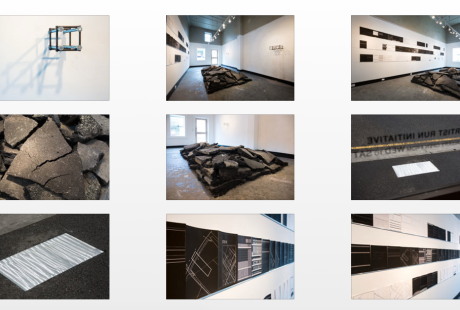23
Jan
Constance Critique no. 4
- By admin
Dirty Big Whole
Review by Bridget Hickey
Photography: Peter Mathew
Last December, Constance Artist Run Initiative (ARI) became a construction site. Provocatively titled Dirty Big Whole, the exhibition saw the excavation of a public artwork from outside the building and the associated waste material re-presented in the gallery space. Conceived by established Hobart artists Lucy Bleach and John Vella, the show provided a complex and intelligent engagement with current issues surrounding the making of contemporary art.
Although Dirty Big Whole involved a display of objects, the exhibition is perhaps better described as a series of processes. Bleach obtained permission from the Hobart City Council to temporarily remove two sculptural aluminium bike racks, part of the Artbikes scheme funded by the Council’s Public Arts Program. Shaped like silhouetted pedestrians, the racks usually provide an unchallenging addition to the streetscape. Bleach filled the holes left by the excavation with aluminium plates, replacing figurative forms with abstracted versions. The artist also displayed the racks’ metal footings inside the gallery, transforming the functional into sculptural objects. Vella’s contribution to the show involved the presentation of paperwork relating to the gallery space, namely Arts Tasmania’s funding and acquittal forms and Bleach’s council permits. These were mounted across the length of one wall, their text blanked out. The final element of the exhibition was produced collaboratively and consisted of displaying the displaced bitumen inside the gallery. Arranged into a large but surprisingly tidy rectangle, the pile was supplemented for aesthetic effect with other material from nearby roadworks.
Bleach and Vella’s actions provide a multi-layered examination of issues surrounding the funding and support for contemporary art. On one level, the work comments on the role of permission and endorsement surrounding contemporary arts practice, and the contradiction between the ideal of artistic freedom and the need to earn a living. This is particularly true of ‘experimental’ artists, whose non-commercial work often relies on government funding and the support of arts organisations. In seeking permission to undertake a process that could be perceived as subversive, Bleach and Vella’s exhibition exposes the ironies inherent within this system. At the same time, their work successfully demonstrates the potential for this kind of practice to question and critique.
On another, related level, the show also taps into current discussion about arts funding in Tasmania specifically. December marked the start of a difficult period for Constance, as the last month before the ARI’s Assistance to Organisations grant expired. From January 2014, it will rely heavily on the generosity of the local arts community to continue as Tasmania’s longest-running ARI. Although the opening of David Walsh’s privately funded Museum of Old and New Art (MONA) has brought unprecedented opportunities and publicity to the local arts scene, its arrival has coincided with an economic downturn and a subsequent reduction in state support for the arts. In presenting a show about funding in a gallery soon to be de-funded, Bleach and Vella’s exhibition could easily be read as a clear-cut political statement. However, Dirty Big Whole chooses to aestheticise bureaucracy, to poeticise rather than polemicise. By relocating an under-utilised permanent public artwork into the more provisional space of an ARI, viewers are encouraged to question which work has more value. However, the answer is left up to the individual.
Bleach and Vella play a significant role as mentors in the local arts community, both teaching at the Tasmanian College of the Arts. With a combined exhibition history of nearly fifty years, their decision to show at Constance ARI is meaningful. While lending support and legitimacy to a space usually designated for emerging practitioners, Bleach and Vella also challenge the expected career pathway for mid-career artists and the artificial structures and expectations that can develop. More than a hole in the ground, Dirty Big Whole is a subversive and playful exhibition that examines the whole system of rules and regulations in which we all must function.


